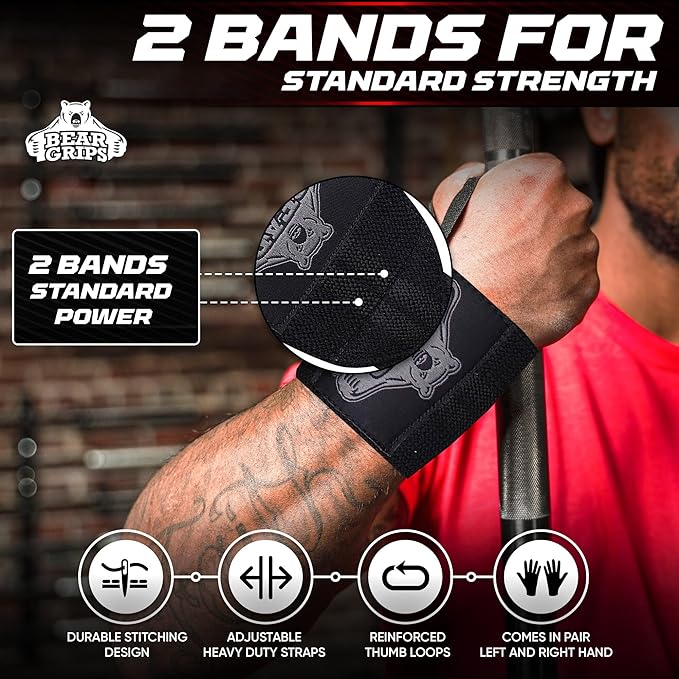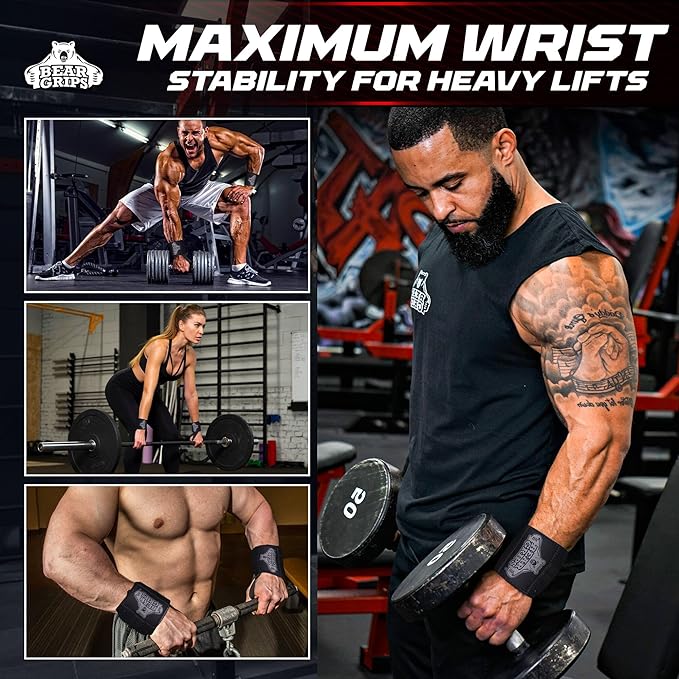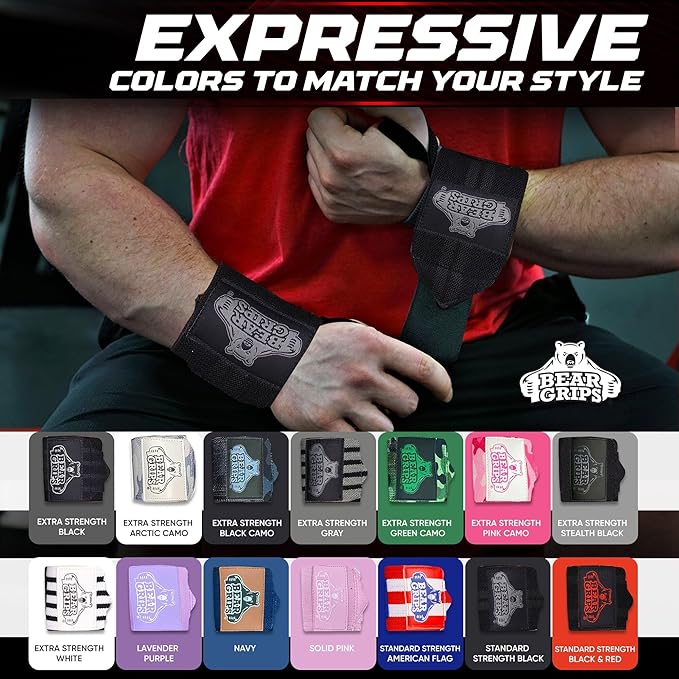
Advantages of Wrist Wraps for Pain Relief and Support
Share
Wrist wraps are a popular accessory in the fitness world, known for their ability to provide pain relief and support to the wrists during intense workouts. Whether you're into weightlifting, CrossFit, or any activity that puts strain on your wrists, wrist wraps can be a game-changer.
One of the key benefits of wrist wraps is their ability to provide pain relief. If you suffer from wrist discomfort or have a nagging injury, wrist wraps can help alleviate the pain by providing compression and stability to the joint. They can also help reduce inflammation and swelling, allowing you to train more comfortably.
Another advantage of wrist wraps is the support they offer. When performing exercises that put pressure on the wrists, such as heavy lifts or dynamic movements, wearing wrist wraps can provide the necessary stability. They help minimize bending and keep the wrists in a neutral position, reducing the risk of injury and allowing you to lift heavier weights with confidence.
It's important to note that wrist wraps should not be used as a substitute for proper technique and form. While they can provide support and pain relief, they should complement your training and not replace the need for strengthening the wrist muscles. Overreliance on wrist wraps can potentially weaken the wrists over time and mask underlying technical errors or poor form that need to be addressed.
Key Takeaways:
- Wrist wraps can provide pain relief and support during intense workouts.
- They can alleviate wrist discomfort and reduce inflammation.
- Wrist wraps offer stability and minimize bending during exercises that stress the wrists.
- Proper technique and form should always be prioritized, with wrist wraps used as a supplement, not a substitute.
- Overreliance on wrist wraps can weaken the wrists and mask technical errors or poor form.
Benefits of Using Wrist Wraps for Lifting
When it comes to heavy lifting, wrist stability is crucial for safety and optimal performance. This is where wrist wraps come in. These specially designed accessories offer several benefits that can enhance your lifting experience.
First and foremost, wrist wraps provide increased wrist stability under heavy loads. By wrapping securely around the wrists, they help to minimize excessive movement and maintain proper alignment during lifts. This stability allows for better force transfer, enabling you to generate more power and improve your pressing strength.

Moreover, wrist wraps help minimize bending during lifts. The wraps act as a solid foundation, preventing your wrists from collapsing or flexing excessively. This is particularly beneficial for dynamic lifts like snatches and cleans, where maintaining a rigid wrist position is crucial.
Using wrist wraps can increase wrist stability under heavy loads, minimize bending during lifts, and provide support during dynamic movements.
Additionally, wrist wraps can decrease stress on tendons. As you lift heavier weights or perform repetitive movements, the tendons in your wrists can become strained. Wrist wraps help to distribute the load more evenly, reducing the strain on your tendons and minimizing the risk of injury.
For individuals with existing wrist discomfort or soreness, wrist wraps can provide much-needed relief. The wraps offer support and compression, which can alleviate pain and discomfort during and after lifting sessions. This can allow you to focus on your workout without being hindered by wrist discomfort.
Summary
By using wrist wraps, you can benefit from increased wrist stability under heavy loads, minimized bending during lifts, decreased stress on tendons, and relief from wrist soreness. These accessories can be a valuable tool for lifters looking to enhance their performance and protect their wrists during intense training sessions.
Drawbacks of Using Wrist Wraps for Lifting
While wrist wraps offer several benefits, it is essential to consider the potential drawbacks associated with their use. Overusing wrist wraps can have negative effects on the wrists over time and may mask technical errors or poor form during lifting exercises.
One of the drawbacks of relying too heavily on wrist wraps is the potential to weaken the grip muscles and tendons. Wrist wraps provide external support to the wrists, which can prevent the muscles from strengthening on their own. This can lead to a reliance on the wraps for wrist stability, resulting in weaker wrists over time.
Another concern is that wrist wraps can mask technical errors or poor form during lifting. By providing additional support and stability, wrist wraps may hide underlying issues or mistakes in lifting technique. This can prevent lifters from addressing these problems and correcting them, potentially leading to long-term complications or injuries.
To illustrate the potential drawbacks of wrist wraps, consider the following table:
| Drawbacks of Wrist Wraps | Impact on Lifters |
|---|---|
| Weaker grip muscles and tendons over time | Reduced ability to develop natural wrist strength and stability |
| Masking of technical errors or poor form | Difficulty in identifying and correcting lifting technique issues |
By understanding these drawbacks, lifters can make informed decisions about the appropriate use of wrist wraps and take steps to mitigate their negative effects.

Who Should Use Wrist Wraps for Lifting
When it comes to using wrist wraps for lifting, not everyone may require them. However, there are specific groups of lifters who can greatly benefit from incorporating wrist wraps into their training routine.
Lifters with Training Experience
Ideal candidates for using wrist wraps are lifters who have at least 6 months of training experience and have already established good technique and wrist stability without the use of wraps. These lifters have likely built a solid foundation of strength and can leverage the added support provided by wrist wraps to enhance their performance.
Lifters Doing Sets to Failure
Another group that can benefit from wrist wraps are lifters who frequently perform sets to failure. These intense sets often push the limits of wrist stability, and wrist wraps can help maintain proper form and prevent wrist fatigue or discomfort that might hinder their performance.
Strength Athletes
Wrist wraps are particularly valuable for strength athletes who regularly engage in activities such as powerlifting, weightlifting, bodybuilding, or CrossFit. These sports involve heavy loads and high-intensity movements that put significant stress on the joints, including the wrists. Wrist wraps can enhance wrist stability and maximize performance during these demanding workouts.
However, it's important to note that beginners who haven't yet mastered proper lifting technique should refrain from using wrist wraps. These individuals need to focus on developing their wrist stability and grip strength organically, without relying on external support. Wrist wraps may mask form errors and hinder the overall development of their lifting skills.
Who Should NOT Use Wrist Wraps for Lifting
While wrist wraps provide support and stability during lifting, they are not suitable for everyone, especially beginners with poor technique or lack of strength. Wrist discomfort and grip issues commonly experienced by beginners are often due to improper form, insufficient strength, or general soreness that can be improved through proper training. It is important for beginners to focus on developing wrist stability and strength without relying on wrist wraps as a solution.
Wrist wraps should be seen as a supplement for lifters with sufficient training experience and stability. They are designed to enhance performance and protect the wrists during heavy lifting and high volume movements, but they should not be used as a substitute for addressing fundamental technique and strength issues.
"Beginners who haven't mastered proper technique or lack the necessary strength should not use wrist wraps."
- Expert Trainer
By avoiding the use of wrist wraps initially, beginners can focus on improving their form, strengthening their wrists, and developing their grip strength. Once they have built a solid foundation, they can then consider incorporating wrist wraps into their training regimen if necessary.
Benefits of Proper Training Without Wrist Wraps
- Improves technique and form
- Enhances wrist stability and strength
- Reduces the risk of dependency on external support
- Allows for better understanding of wrist mechanics
By emphasizing proper training without wrist wraps, beginners can lay the groundwork for long-term success and injury prevention in their lifting journey.
What Types of Wrist Wraps Should You Get
When it comes to choosing wrist wraps, there are three main types to consider: classic velcro wraps, flexibility cloth wraps, and extra-stiff velcro wraps. Each type offers unique benefits and is suited for different lifting needs.
Classic Velcro Wraps
Classic velcro wraps are a popular choice among lifters due to their versatility and support. These wraps provide a combination of support and stretch, making them suitable for a wide range of lifts. Whether you're performing heavy bench presses or overhead presses, classic velcro wraps can help stabilize your wrists and enhance your lifting performance.
Flexibility Cloth Wraps
For lifters looking for both support and flexibility, flexibility cloth wraps are an excellent option. These wraps are specifically designed for dynamic lifts, such as snatches and cleans, where wrist mobility is crucial. The flexibility cloth wraps offer a balance of support and freedom of movement, allowing you to perform explosive movements with added wrist stability.
Extra-Stiff Velcro Wraps
If you're an advanced lifter handling heavy loads, extra-stiff velcro wraps are the way to go. These wraps are constructed with maximum stiffness and stability in mind, providing the utmost support for intense lifting sessions. Extra-stiff velcro wraps are commonly used by strength athletes, powerlifters, and those who engage in heavy compound movements.
Choosing the right type of wrist wrap depends on your lifting goals, preferences, and the specific demands of your workouts. It's always important to consider your individual needs and consult with a fitness professional if you're unsure which type of wrap is best for you.

Avoid These Mistakes When Using Wrist Wraps for Lifting
When it comes to using wrist wraps for lifting, it's crucial to steer clear of common mistakes that can hinder your progress and potentially cause harm. By avoiding these pitfalls, you can maximize the benefits of wrist wraps and protect your wrists effectively.
1. Overuse of Wraps
One of the most common mistakes lifters make is overusing wrist wraps. While these wraps are beneficial for providing extra support, relying on them excessively can weaken your wrists and tendons over time. It's important to use wrist wraps only when necessary, such as during heavy lifts or when recovering from wrist injuries. By using them judiciously, you can develop stronger natural wrist stability and prevent any long-term damage.
2. Wearing Wraps Too Low or High
The position at which you wear your wrist wraps is critical for optimal support and effectiveness. Wearing them too low or too high on your wrists can limit their effectiveness and potentially lead to discomfort or inadequate support. Wraps should be worn just above or below the joint, depending on your preference and comfort. This ensures that the wraps provide targeted support to the wrist joint, stabilizing it during lifts and preventing excessive bending or hyperextension.
3. Not Wearing the Right Type of Wrap
Choosing the right type of wrist wrap is essential for maximizing their benefits. Different lifts and activities may call for different levels of support and flexibility. It's important to select a wrist wrap that suits your specific needs and the type of lifts you perform. Here are a few common types of wrist wraps:
- Classic Velcro Wraps: These wraps offer a balance between support and stretch, making them versatile for a wide range of lifts.
- Flexibility Cloth Wraps: Ideal for dynamic lifts, these wraps provide both support and flexibility.
- Extra-Stiff Velcro Wraps: Recommended for advanced lifters lifting heavy loads, these wraps offer maximum stiffness and stability.
Choosing the right type of wrist wrap will ensure that you have the necessary support and stability for your specific lifting goals.
By avoiding these common mistakes with wrist wraps, you can enhance your lifting performance, protect your wrists, and prevent potential injuries. Remember to use wrist wraps judiciously, wear them in the correct position, and select the appropriate type of wrap for your specific lifting needs. With the right approach, wrist wraps can be a valuable tool in your lifting arsenal.
Benefits of Wrist Wraps for Weightlifting and CrossFit
Wrist wraps are indispensable accessories for weightlifters and CrossFit enthusiasts, offering a multitude of benefits that enhance performance and support overall wrist health. Whether you're engaging in heavy lifts, high volume movements, or recovering from wrist injuries, wrist wraps can be a game-changer.
Stabilize Wrists for Heavy Lifts
One of the primary benefits of wrist wraps is their ability to stabilize the wrists during heavy lifts. By wrapping tightly around the wrists, these supportive accessories prevent hyperextension and promote proper wrist placement, allowing you to focus on maximizing your lifting potential without worrying about compromised wrist alignment.
Support for High Volume Movements
For weightlifters and CrossFitters engaged in high volume movements, such as handstand push-ups and overhead squats, wrist wraps provide invaluable support. These demanding exercises often place significant stress on the wrist joint, but with the added stability and compression provided by wrist wraps, you can minimize the strain and discomfort, optimizing your performance and avoiding potential injuries.
Recover Faster from Injuries
When it comes to recovering from wrist injuries, wrist wraps can be instrumental in the healing process. By offering support and stability, wrist wraps assist in relieving pressure on injured wrists, allowing them to recover faster and regain strength. Whether you're dealing with sprains, strains, or other wrist-related injuries, wrist wraps provide the necessary assistance during rehabilitation.
"Wrist wraps provide stability and support, allowing for proper wrist alignment during heavy lifts and high volume movements." - Mike Johnson, Certified Strength and Conditioning Specialist
Overall, wrist wraps are essential tools for weightlifters and CrossFitters, offering stability, support, and injury recovery benefits. However, it's crucial to use wrist wraps judiciously and not solely rely on them as a permanent solution. Proper technique and form should always remain a priority, and beginners should focus on developing wrist stability and grip strength before incorporating wrist wraps into their training routine.
Conclusion
Wrist wraps can be a valuable tool for lifters, offering support and stability during heavy lifting and high volume movements. By securing the wrists, they potentially reduce the risk of wrist injuries. However, it is important to use wrist wraps judiciously and not rely on them as a permanent solution.
While wrist wraps provide benefits, it is crucial to prioritize proper technique and form. Beginners should focus on developing wrist stability and strength naturally, without relying on wraps. Wrist wraps should only be used when necessary, and lifters with at least 6 months of training experience and established good technique should consider incorporating them into their lifting routine.
When used correctly, wrist wraps can enhance performance and protect the wrists during demanding exercises. However, lifters should not solely rely on wrist wraps and neglect the importance of proper training and strengthening. By striking a balance between support and natural wrist development, lifters can maximize the advantages of wrist wraps while minimizing potential drawbacks.
Get best functioning wrist wraps for gym at Bear Grips right now!
Shop at Amazon.com Now!
FAQ
What are wrist wraps?
Wrist wraps are worn to support the wrist joint and provide stability during activities that put pressure on the wrists.
What are the benefits of using wrist wraps for lifting?
Wrist wraps can increase wrist stability under heavy loads, minimize bending during lifts, and potentially decrease stress on tendons.
What are the drawbacks of using wrist wraps for lifting?
Overuse of wrist wraps can weaken the wrists over time and they may mask underlying technical errors or poor form.
Who should use wrist wraps for lifting?
Ideal candidates for using wrist wraps are lifters who have at least 6 months of training experience and have established good technique and wrist stability without wraps.
Who should NOT use wrist wraps for lifting?
Beginners who haven't mastered proper technique or lack the necessary strength should not use wrist wraps.
What types of wrist wraps should you get?
There are three main types of wrist wraps available: classic velcro wraps, flexibility cloth wraps, and extra-stiff velcro wraps.
What common mistakes should you avoid when using wrist wraps for lifting?
It's important to avoid overusing wrist wraps, wearing them at the correct position, and choosing the right type of wrap based on your needs and the specific lifts you are performing.
What are the benefits of wrist wraps for weightlifting and CrossFit?
Wrist wraps provide stability for heavy lifts, support for high volume movements, and aid in the recovery of wrist injuries.
Should I rely solely on wrist wraps for lifting?
Wrist wraps should be used judiciously and not relied upon as a permanent solution. Proper technique and form should always be prioritized.


